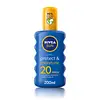What's inside
What's inside
 Key Ingredients
Key Ingredients

 Benefits
Benefits

 Concerns
Concerns

 Ingredients Side-by-side
Ingredients Side-by-side

Water
Skin ConditioningDiethylamino Hydroxybenzoyl Hexyl Benzoate
UV FilterOctocrylene
UV AbsorberHomosalate
Skin ConditioningDibutyl Adipate
EmollientButyl Methoxydibenzoylmethane
UV AbsorberCetyl Dimethicone
EmollientCetearyl Alcohol
EmollientPotassium Cetyl Phosphate
EmulsifyingGlycerin
HumectantUndecane
EmollientC8-22 Alkyl Acrylates/Methacrylic Acid Crosspolymer
Diethylhexyl Butamido Triazone
UV AbsorberTridecane
PerfumingPhenoxyethanol
PreservativePropyl Alcohol
SolventHydroxyethyl Acrylate/Sodium Acryloyldimethyl Taurate Copolymer
Emulsion StabilisingBenzoic Acid
MaskingSqualane
EmollientCaprylyl Glycol
EmollientDisodium EDTA
Dehydroacetic Acid
PreservativeEthylhexylglycerin
Skin ConditioningPolysorbate 60
EmulsifyingTocopherol
AntioxidantHelianthus Annuus Seed Oil
EmollientWater, Diethylamino Hydroxybenzoyl Hexyl Benzoate, Octocrylene, Homosalate, Dibutyl Adipate, Butyl Methoxydibenzoylmethane, Cetyl Dimethicone, Cetearyl Alcohol, Potassium Cetyl Phosphate, Glycerin, Undecane, C8-22 Alkyl Acrylates/Methacrylic Acid Crosspolymer, Diethylhexyl Butamido Triazone, Tridecane, Phenoxyethanol, Propyl Alcohol, Hydroxyethyl Acrylate/Sodium Acryloyldimethyl Taurate Copolymer, Benzoic Acid, Squalane, Caprylyl Glycol, Disodium EDTA, Dehydroacetic Acid, Ethylhexylglycerin, Polysorbate 60, Tocopherol, Helianthus Annuus Seed Oil
Water
Skin ConditioningAlcohol Denat.
AntimicrobialGlycerin
HumectantEthylhexyl Salicylate
UV AbsorberIsopropyl Palmitate
EmollientDibutyl Adipate
EmollientButyl Methoxydibenzoylmethane
UV AbsorberC12-15 Alkyl Benzoate
AntimicrobialBis-Ethylhexyloxyphenol Methoxyphenyl Triazine
Skin ConditioningGlyceryl Stearate
EmollientPhenylbenzimidazole Sulfonic Acid
UV AbsorberTocopheryl Acetate
AntioxidantHydrogenated Rapeseed Oil
EmollientCopernicia Cerifera Cera
EmollientCetyl Palmitate
EmollientC18-38 Alkyl Hydroxystearoyl Stearate
EmollientSodium Stearoyl Glutamate
CleansingMicrocrystalline Cellulose
AbsorbentXanthan Gum
EmulsifyingCellulose Gum
Emulsion StabilisingCaprylyl Glycol
EmollientPhenoxyethanol
PreservativeTrisodium EDTA
Sodium Hydroxide
BufferingSodium Chloride
MaskingLinalool
PerfumingBenzyl Alcohol
PerfumingAlpha-Isomethyl Ionone
PerfumingCitronellol
PerfumingAnise Alcohol
PerfumingParfum
MaskingWater, Alcohol Denat., Glycerin, Ethylhexyl Salicylate, Isopropyl Palmitate, Dibutyl Adipate, Butyl Methoxydibenzoylmethane, C12-15 Alkyl Benzoate, Bis-Ethylhexyloxyphenol Methoxyphenyl Triazine, Glyceryl Stearate, Phenylbenzimidazole Sulfonic Acid, Tocopheryl Acetate, Hydrogenated Rapeseed Oil, Copernicia Cerifera Cera, Cetyl Palmitate, C18-38 Alkyl Hydroxystearoyl Stearate, Sodium Stearoyl Glutamate, Microcrystalline Cellulose, Xanthan Gum, Cellulose Gum, Caprylyl Glycol, Phenoxyethanol, Trisodium EDTA, Sodium Hydroxide, Sodium Chloride, Linalool, Benzyl Alcohol, Alpha-Isomethyl Ionone, Citronellol, Anise Alcohol, Parfum
Ingredients Explained
These ingredients are found in both products.
Ingredients higher up in an ingredient list are typically present in a larger amount.
Also known as Avobenzone, this ingredient is a chemical sunscreen filter that provides protection in the UV-A range.
Avobenzone is globally approved and is the most commonly used UV-A filter in the world.
Studies have found that avobenzone becomes ineffective when exposed to UV light (it is not photostable; meaning that it breaks down in sunlight). Because of this, formulations that include avobenzone will usually contain stabilizers such as octocrylene.
However, some modern formulations (looking at you, EU!) are able to stabilize avobenzone by coating the molecules.
Avobenzone does not protect against the UV-B range, so it's important to check that the sunscreen you're using contains other UV filters that do!
The highest concentration of avobenzone permitted is 3% in the US, and 5% in the EU.
Learn more about Butyl MethoxydibenzoylmethaneCaprylyl Glycol is a humectant and emollient, meaning it attracts and preserves moisture.
It is a common ingredient in many products, especially those designed to hydrate skin. The primary benefits are retaining moisture, skin softening, and promoting a healthy skin barrier.
Though Caprylyl Glycol is an alcohol derived from fatty acids, it is not the kind that can dry out skin.
This ingredient is also used as a preservative to extend the life of products. It has slight antimicrobial properties.
Learn more about Caprylyl GlycolDibutyl Adipate is an emollient and solvent. It is created from butyl alcohol and adipic acid.
As a solvent, Dibutyl Adipate helps mix and disperse ingredients evenly.
Dibutyl Adipate is soluble in water and organic solvents. It does not absorb UV rays.
Learn more about Dibutyl AdipateGlycerin is already naturally found in your skin. It helps moisturize and protect your skin.
A study from 2016 found glycerin to be more effective as a humectant than AHAs and hyaluronic acid.
As a humectant, it helps the skin stay hydrated by pulling moisture to your skin. The low molecular weight of glycerin allows it to pull moisture into the deeper layers of your skin.
Hydrated skin improves your skin barrier; Your skin barrier helps protect against irritants and bacteria.
Glycerin has also been found to have antimicrobial and antiviral properties. Due to these properties, glycerin is often used in wound and burn treatments.
In cosmetics, glycerin is usually derived from plants such as soybean or palm. However, it can also be sourced from animals, such as tallow or animal fat.
This ingredient is organic, colorless, odorless, and non-toxic.
Glycerin is the name for this ingredient in American English. British English uses Glycerol/Glycerine.
Learn more about GlycerinPhenoxyethanol is a preservative that has germicide, antimicrobial, and aromatic properties. Studies show that phenoxyethanol can prevent microbial growth. By itself, it has a scent that is similar to that of a rose.
It's often used in formulations along with Caprylyl Glycol to preserve the shelf life of products.
Water. It's the most common cosmetic ingredient of all. You'll usually see it at the top of ingredient lists, meaning that it makes up the largest part of the product.
So why is it so popular? Water most often acts as a solvent - this means that it helps dissolve other ingredients into the formulation.
You'll also recognize water as that liquid we all need to stay alive. If you see this, drink a glass of water. Stay hydrated!
Learn more about Water